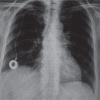Identification of catheter misplacement in early port CVC dysfunction
- PMID: 30150892
- PMCID: PMC6103231
- DOI: 10.5114/wo.2018.77044
Identification of catheter misplacement in early port CVC dysfunction
Abstract
The use of port central venous catheters (CVCs) for chemotherapeutical use has seen exponential growth over the last decades. However, port CVC misplacement may lead to catheter malfunction (such as partial or total catheter blockade), which might be complicated by thrombosis and catheter superinfections, and these in turn may lead to pulmonary embolism and bloodstream infections. The overall occurrence of port CVC misplacement is up to 6%; nonetheless, port CVC misplacement may occur in up to 67% of patients with early CVC dysfunction (occurring within three months of catheter insertion). Thereafter, the prompt evaluation of catheter position among patients with first-trimester CVC dysfunction is extremely important. The aim of the present manuscript is to support medical oncologists, haematologists, and clinicians in timely suspicion and recognition of port CVC misplacement among patients with early CVC dysfunction. Radiological educational iconographic materials that will assist a prompt estimate of port-CVC dislocation are provided.
Keywords: CVCs; central venous catheters; chemotherapy; dysfunction; misplacement; port.
Conflict of interest statement
The authors declare no conflict of interest.
Figures


















Similar articles
-
[Venous thromboembolism associated with long-term use of central venous catheters in cancer patients].Pathol Biol (Paris). 2008 Jun;56(4):211-9. doi: 10.1016/j.patbio.2008.02.002. Epub 2008 Apr 18. Pathol Biol (Paris). 2008. PMID: 18395994 Review. French.
-
Misplacement of Tunneled Hemodialysis Catheter into Azygos Vein: Left or Right Jugular Insertion Has Similar Susceptibility.Blood Purif. 2019;48(1):1-9. doi: 10.1159/000497231. Epub 2019 Feb 14. Blood Purif. 2019. PMID: 30763936 Review.
-
Educational interventions alone and combined with port protector reduce the rate of central venous catheter infection and colonization in respiratory semi-intensive care unit.BMC Infect Dis. 2019 Mar 4;19(1):215. doi: 10.1186/s12879-019-3848-z. BMC Infect Dis. 2019. PMID: 30832598 Free PMC article.
-
Is Routine Chest X-Ray After Ultrasound-Guided Central Venous Catheter Insertion Choosing Wisely?: A Population-Based Retrospective Study of 6,875 Patients.Chest. 2018 Jul;154(1):148-156. doi: 10.1016/j.chest.2018.02.017. Epub 2018 Mar 6. Chest. 2018. PMID: 29501497
-
[Venous thromboembolism associated with long-term use of central venous catheters in cancer patients].Rev Med Interne. 2007 Jul;28(7):471-83. doi: 10.1016/j.revmed.2007.03.002. Epub 2007 Apr 19. Rev Med Interne. 2007. PMID: 17561314 Review. French.
Cited by
-
Closed thoracic drainage in elderly patients with chronic obstructive pulmonary disease complicated with spontaneous pneumothorax: A retrospective study.World J Clin Cases. 2023 Sep 26;11(27):6415-6423. doi: 10.12998/wjcc.v11.i27.6415. World J Clin Cases. 2023. PMID: 37900247 Free PMC article.
-
Vascular Port Complication Leading to Surgery of Pulmonary Artery Branch-A Case Report.Medicina (Kaunas). 2024 Jul 4;60(7):1093. doi: 10.3390/medicina60071093. Medicina (Kaunas). 2024. PMID: 39064522 Free PMC article.
References
-
- Sousa B, Furlanetto J, Hutka M, Gouveia P, Wuerstlein R, Mariz JM, Pinto D, Cardoso F, ESMO Guidelines Committee Central venous accesss in Oncology: ESMO Clinical Practice Guidelines. Ann Oncol. 2015;26(Suppl. 5):152–168. - PubMed
-
- Schiffer CA, Mangou PB, Wade JC, et al. Central Venous Catheter care for the patient with cancer: American Society of Clinical Oncology Clinical Practice Guideline. J Clin Oncol. 2013;17:1357–1370. - PubMed
-
- Granic M, Zdravkovic D, Krstajic S, et al. Totally implantable central venous catheters of the port-a-cath type: complications due to its use in the treatment of cancer patients. J BUON. 2014;19:842–846. - PubMed
-
- Mauri D, Roumbkou S, Michalopoulou S, Tsali L, et al. Port central venous catheters associated bloodstream infection during outpatient-based chemotherapy. Med Oncol. 2010;27:1309–1313. - PubMed
LinkOut - more resources
Full Text Sources
Other Literature Sources
